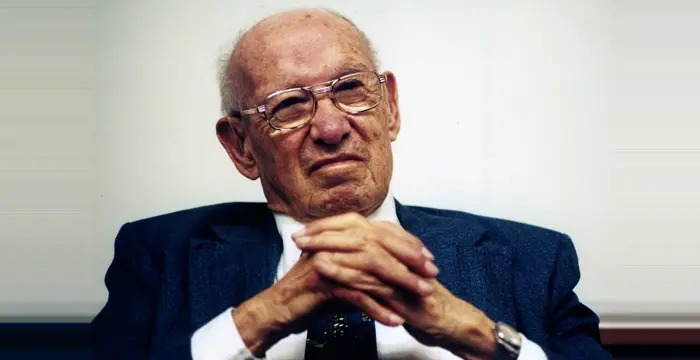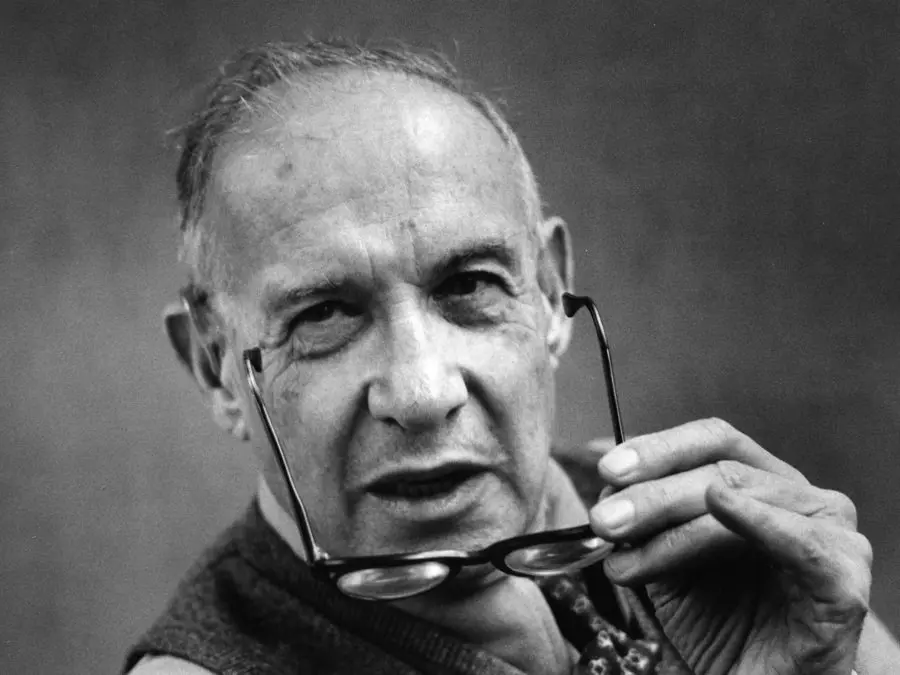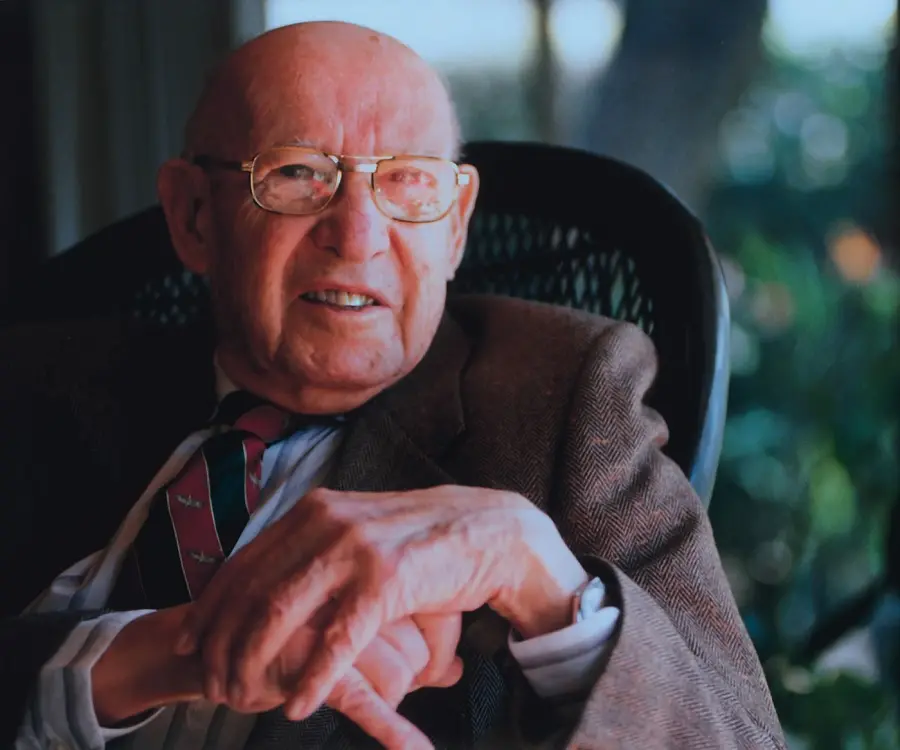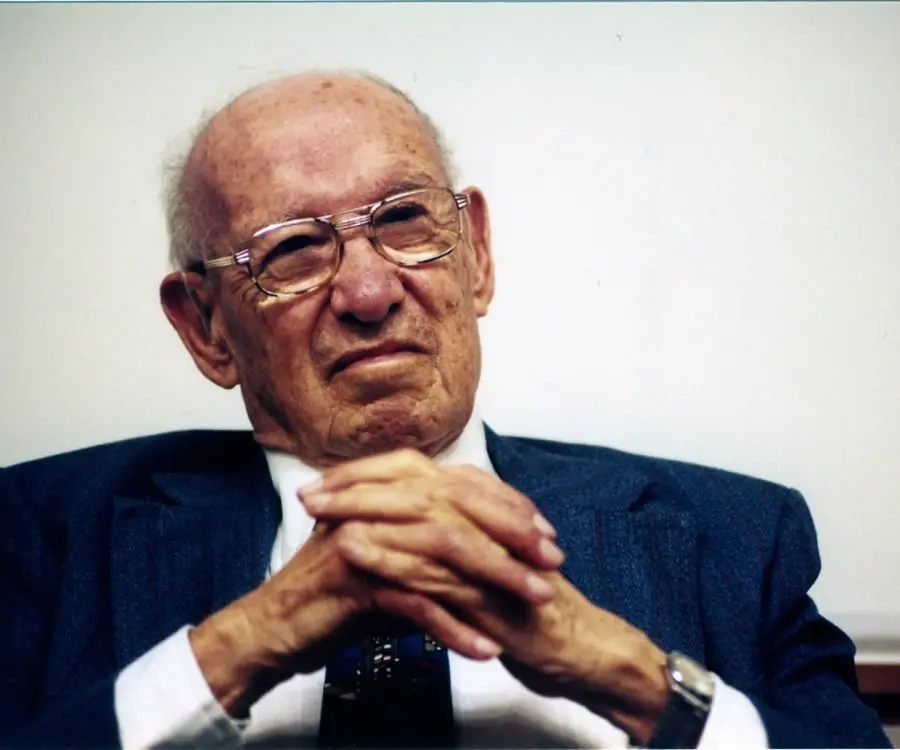
Peter Drucker - Management Consultant, Facts and Childhood
Peter Drucker's Personal Details
Peter Drucker was an Austrian-American management consultant, academician, author and a self-defined “social ecologist”
| Information | Detail |
|---|---|
| Birthday | November 19, 1909 |
| Died on | November 11, 2005 |
| Nationality | American |
| Famous | Intellectuals & Academics, Management Thinkers, Management Consultant |
| Spouses | Doris Schmitz |
| Known as | Peter Ferdinand Drucker |
| Universities |
|
| Birth Place | Vienna, Austria |
| Gender | Male |
| Father | Adolph Bertram Drucker |
| Mother | Caroline Bond Drucker |
| Sun Sign | Scorpio |
| Born in | Vienna, Austria |
| Famous as | Management Consultant |
| Died at Age | 95 |
Peter Drucker's photo
Who is Peter Drucker?
Peter Drucker was an Austrian-American management consultant, academician, author and a self-defined “social ecologist”. Peter is among the best known and most influential thinkers on the matter of management theory and practices. Born in Vienna, after completing his education at the local gymnasium he moved to Germany, where he started working as a journalist, concurrently studying law in private, receiving his doctoral degree from the University of Frankfurt. Thereafter, he moved first to London and then to the USA, becoming a naturalized citizen of the United States in 1943. Starting his career in the USA as an advisor to British banks and a correspondent to several journals and newspapers he soon switched to academics, continuing to write all along. However, it was in his role as a management consultant that he reached his peak. It started with an invitation from General Motors to analyze its organizational structure, resulting in his 1946 book, ‘Concept of the Corporation’, which offers assessment of large corporations as social institutions. Later he served as consultant to many well-known corporations, governmental departments as well as non-governmental organizations; all the while continuing to teach and write. Working almost till the end, he died at the age of ninety-five in Claremont, USA.
Childhood & Early Years
Peter Druker was born on November 19, 1909 in Kaasgrabengasse, at that time a tranquil avenue in the Viennese suburb of Döbling. His father, Adolph Bertram Drucker, was an economist and a lawyer, occupying a high position in the government service.
His mother, Caroline Bond Drucker, was a student of medicine with an interest in psychiatry. A strong-willed and independent lady, she was the one who ran the household. For a brief period, she also worked in the medicinal field.
The couple was an ardent supporter of social reformer Eugenia "Genia" Schwarzwald. They were also socially very active, holding frequent soirées at home. In these gatherings, everybody from state officials to lawyers, doctors, psychologists, scientists and philosophers were invited and they would discuss all kinds of topics over dinner.
Peter was the elder of his parents’ two children, having a younger brother named Gerhard. From an early age, Peter and his brother were allowed to take part in the soirées. Thus Peter came to know intellectual giants like Joseph Schumpeter, Friedrich Hayek, Ludwig von Mises and Hans Kelson from an early age.
It is not known where he started his education; but when he was in the fourth grade, he was enrolled at a co-educational school set up by Genia. Here, he imbibed an appreciation for craftsmanship, respect for the task, value of discipline and also learned to organize his tasks.
Genia was an important influence on Peter’s early life. Although he was still in his teens, she always invited him to the talk shows she arranged at her summer villa "Seeblick" in Grundlsee, allowing him to ask questions. His adoring grandmother also played an important part in his upbringing.
In Germany
In 1927, Peter Drucker passed from Döbling Gymnasium and thereafter moved to Hamburg for a one-year apprenticeship at a cotton export-import firm. But due to the apathy of the manager he did learn anything. Instead, he spent the time reading—mostly literature and 19th century history.
Sometime during this period, he discovered the work of Danish philosopher Kierkegaar, which would later have immense influence on him. Moreover, this was also the time when he made his first attempt at journalism, writing articles for ‘Der Österreichische Volkswirt’. He also started studying law at the behest of his father.
In 1928, Peter Drucker moved to Frankfurt, where he found employment with the F’rankfurter General-Anzeiger’, a daily newspaper and a rival to the famous ‘Frankfurter Zeitung’. Here, he quickly rose to become one of the paper’s three editors.
Although Peter was primarily responsible for the foreign affairs and economic departments, he was required to work in all the departments, including women’s section or even music. He also had to cover political rallies and press conference, thus acquiring a wide experience.
In 1931, studying in private, Peter Drucker earned his doctorate in international and public law from the University of Frankfurt. Thereafter, he remained in Germany for two more years.In 1933, when Hitler came to power, Peter left the country, moving first to England and then to the USA.
In London
On reaching London in 1933, Peter Ducker first obtained the position of a trainee at an insurance company. Later he was appointed an economist at a bank, whose director was an Austrian. All the while, he continued to record his experiences in Germany since the takeover of the Nationalist Socialist Party.
In 1934, he was sponsored by his director to attend Lord John Maynard Keynes’ seminar in Cambridge; but was sorely disappointed. He later said, while Keynes was only interested in the behavior of commodities, he wanted to learn about the behavior of people.
In 1936, he published his first work, 'Die Judenfrage in Deutschland' (The Jewish Question in Germany). It was later revised and republished in English as ‘The End of Economic Man’ and met with a broad and positive response. However in Germany, the book was banned and burned.
In the USA
In 1937, Drucker moved to the USA, where he initially worked as a freelance journalist for Harper. Concurrently, he began contributing to the Washington Post and a few British financial publications before embarking on an academic career as professor of economics at Sarah Lawrence College in Bronxville, New York.
In 1942, he was appointed a professor of political science and philosophy at Bennington College in Vermont, a position he held till 1949. He had later said, his main impetus in teaching was to find out what he thought.
Also in 1942, he had his second work, ‘The Future of Industrial Man’, published. In this book, he tried to decipher how decision-makers of large corporations impacted the society in an industrially developed country. The work opened another avenue for him.
In 1943, General Motors, at that time the world’s largest corporation, asked him to conduct a two-year social-scientific analysis of its management practices. His colleagues advised him not to accept the offer because it would mean end of his academic career. Nonetheless, Drucker decided to accept the challenge.
For next two years, Drucker attended every board meeting at General Motor, analyzing decisions made and also the production processes. He also visited the plants, conducting countless interviews with workers, departmental heads as well as top managers.
In 1946, Drucker published the results of this study as ‘Concept of the Corporation’. Although the focus was on General Motors, he went beyond it, discussing the corporation as a social institution. He also recommended decentralization of power and rethink in many of the company’s long standing policies.
The top management at the General Motors was highly disappointed with the book, going to the extent of forbidding it. It was also criticized by many others as it posed a challenge to their managerial authority; the only exception being Henry Ford II, who used its ideas to reconstruct his company.
In spite of the criticism, the book laid the foundations of management as a scientific discipline. In 1950, Drucker was appointed Professor of Management at the New York University, where he remained until 1971.
In 1971, Drucker moved to California as the Clarke Professor of Social Science and Management at Claremont Graduate University, then known as Claremont Graduate School. It was here that he established one of the first executive MBA programs for working professionals in the USA.
All the while he continued to act as consultant for number of major corporations, such as General Electric, Coca-Cola, Citicorp, IBM and Intel. In addition, he worked with many governmental departments as well as non-governmental organizations, both home and abroad.
He also continued writing, producing 39 books in his lifetime. Most of these books focused on relationship among men rather than on numbers, teaching how to bring out the best in the employees. They also taught workers how they could lead a dignified life in an industrial set up.
Although he remained with the Claremont Graduate University till his death in 2005, he took his last classes in 2002, at that time 92 years old. Meanwhile in 1999, he established the Drucker Archives at the same University, which in 2006 became the Drucker Institute.
Major Works
‘The End of Economic Man’, published first in 1939, is recognized as one of Drucker’s cornerstone work. The book explains the consequences of war and its resulting upheavals, concentrating on the social as well as political structure of Europe, which gave rise to the Nazi power.
’The Essential Drucker’ is another of his well-known works. Written in 2001, the book summarizes the sixty years of his work on management and covers the basic principle of management along with its challenges, problems and opportunities. It also provides the tool with which deal with future challenges.
Awards & Achievements
In 1966, he was awarded the Order of the Sacred Treasure, 3rd class by the government of Japan.
In 1969 he was awarded Presidential Citation, the highest honor awarded by New York University.
On July 9, 2002, Drucker received the Presidential Medal of Freedom from US President George W. Bush.
In June 2004, he received the McKinsey Award from the Harvard Business Review for his article, ‘What Makes an Effective Executive’.
He received several honors from government of Austria and they include the Grand Silver Medal for Services to the Republic of Austria (1974), the Grand Gold Decoration for Services to the Republic of Austria in (1991) and the Austrian Cross of Honour for Science and Art, 1st class (1999)
He received 25 honorary doctorates from different universities in the USA, Belgium, Czechoslovakia, England, Spain and Switzerland.
Personal Life & Legacy
In 1934, Peter Drucker married Doris Schmitz, whom he had known since he was a student at the University of Frankfurt. They had four children; three daughters and one son.
In 1943, Drucker became a naturalized American citizen. He had a varied interest and an affinity to Japanese culture, coauthoring a book on Japanese painting. His works were also very popular in Japan.
Even after he stopped taking classes, Drucker continued to work, acting as consultant to business houses as well as non-profit organizations. In many cases, he did not take any fees.
Drucker died November 11, 2005 in Claremont, California of natural causes. He was then ninety-five years old and was survived by his wife, four children and six grandchildren.
In 1996, Drucker was inducted into the Junior Achievement US Business Hall of Fame.
In 2009, he was posthumously inducted into Outsourcing Hall of Fame by the International Association of Outsourcing Professionals.
His ‘The Practice of Management’ (1954) was declared the third most influential management book of the century by the Fellows of the Academy of Management.
In October 2009, to commemorate his birth centenary, the Eleventh Street between College Avenue and Dartmouth Avenue in Claremont was renamed ‘Drucker Way’.
Trivia
Apart from his books on managements, Drucker had written two novels and one autobiography. He had also made eight educational films on management topics.
’Moshi Kōkō Yakyū no Joshi Manager ga Drucker no "Management" o Yondara’ is Japanese novel by Natsumi Iwasaki. In this novel, Minami Kawashima, a high school girl, manages the baseball team of her school, using tricks from Drucker's 1973 book, ‘Management: Tasks, Responsibilities, Practices’. It was later adapted into a ten episode television series by Nippon Hōsō Kyōka.
// Famous Intellectuals & Academics
Bertil Gotthard Ohlin
Bertil Gotthard Ohlin was a famous Swedish economist. This biography profiles his childhood, family life & achievements.
Emily Greene Balch
Emily Greene Balch was an American economist, sociologist and pacifist who won the 1946 Nobel Peace Prize. This biography of Emily Greene Balch provides detailed information about her childhood, life, achievements, works & timeline.
Martin Buber
One of the greatest philosophers to have ever walked on earth, Martin Buber contributions to philosophy is a long-standing one. Explore all about his profile, childhood, life and timeline here.
Peter Drucker's awards
| Year | Name | Award |
|---|---|---|
Other | ||
| 0 | - United States Poet Laureate | |
| 0 | ||
| 0 | - Congressional Gold Medal | |
| 0 | - Bollingen Prize | |
| 0 | ||
| 0 | - Robert Frost Medal | |
| 0 | ||
| 0 | - American Academy of Arts and Letters Gold Medal for Poetry | |
| 0 | 2002 - Presidential Medal of Freedom | |
| 0 | 2004 - McKinsey Award | |
| 0 | - Pulitzer Prize for Poetry | |
Peter Drucker biography timelines
- // 19th Nov 1909Peter Druker was born on November 19, 1909 in Kaasgrabengasse, at that time a tranquil avenue in the Viennese suburb of Döbling. His father, Adolph Bertram Drucker, was an economist and a lawyer, occupying a high position in the government service.
- // 1927In 1927, Peter Drucker passed from Döbling Gymnasium and thereafter moved to Hamburg for a one-year apprenticeship at a cotton export-import firm. But due to the apathy of the manager he did learn anything. Instead, he spent the time reading—mostly literature and 19th century history.
- // 1928In 1928, Peter Drucker moved to Frankfurt, where he found employment with the F’rankfurter General-Anzeiger’, a daily newspaper and a rival to the famous ‘Frankfurter Zeitung’. Here, he quickly rose to become one of the paper’s three editors.
- // 1931 To 1933In 1931, studying in private, Peter Drucker earned his doctorate in international and public law from the University of Frankfurt. Thereafter, he remained in Germany for two more years.In 1933, when Hitler came to power, Peter left the country, moving first to England and then to the USA.
- // 1933On reaching London in 1933, Peter Ducker first obtained the position of a trainee at an insurance company. Later he was appointed an economist at a bank, whose director was an Austrian. All the while, he continued to record his experiences in Germany since the takeover of the Nationalist Socialist Party.
- // 1934In 1934, he was sponsored by his director to attend Lord John Maynard Keynes’ seminar in Cambridge; but was sorely disappointed. He later said, while Keynes was only interested in the behavior of commodities, he wanted to learn about the behavior of people.
- // 1934In 1934, Peter Drucker married Doris Schmitz, whom he had known since he was a student at the University of Frankfurt. They had four children; three daughters and one son.
- // 1936In 1936, he published his first work, 'Die Judenfrage in Deutschland' (The Jewish Question in Germany). It was later revised and republished in English as ‘The End of Economic Man’ and met with a broad and positive response. However in Germany, the book was banned and burned.
- // 1937In 1937, Drucker moved to the USA, where he initially worked as a freelance journalist for Harper. Concurrently, he began contributing to the Washington Post and a few British financial publications before embarking on an academic career as professor of economics at Sarah Lawrence College in Bronxville, New York.
- // 1939‘The End of Economic Man’, published first in 1939, is recognized as one of Drucker’s cornerstone work. The book explains the consequences of war and its resulting upheavals, concentrating on the social as well as political structure of Europe, which gave rise to the Nazi power.
- // 1942 To 1949In 1942, he was appointed a professor of political science and philosophy at Bennington College in Vermont, a position he held till 1949. He had later said, his main impetus in teaching was to find out what he thought.
- // 1942Also in 1942, he had his second work, ‘The Future of Industrial Man’, published. In this book, he tried to decipher how decision-makers of large corporations impacted the society in an industrially developed country. The work opened another avenue for him.
- // 1943In 1943, General Motors, at that time the world’s largest corporation, asked him to conduct a two-year social-scientific analysis of its management practices. His colleagues advised him not to accept the offer because it would mean end of his academic career. Nonetheless, Drucker decided to accept the challenge.
- // 1943In 1943, Drucker became a naturalized American citizen. He had a varied interest and an affinity to Japanese culture, coauthoring a book on Japanese painting. His works were also very popular in Japan.
- // 1946In 1946, Drucker published the results of this study as ‘Concept of the Corporation’. Although the focus was on General Motors, he went beyond it, discussing the corporation as a social institution. He also recommended decentralization of power and rethink in many of the company’s long standing policies.
- // 1950 To 1971In spite of the criticism, the book laid the foundations of management as a scientific discipline. In 1950, Drucker was appointed Professor of Management at the New York University, where he remained until 1971.
- // 1954His ‘The Practice of Management’ (1954) was declared the third most influential management book of the century by the Fellows of the Academy of Management.
- // 1966In 1966, he was awarded the Order of the Sacred Treasure, 3rd class by the government of Japan.
- // 1969In 1969 he was awarded Presidential Citation, the highest honor awarded by New York University.
- // 1971In 1971, Drucker moved to California as the Clarke Professor of Social Science and Management at Claremont Graduate University, then known as Claremont Graduate School. It was here that he established one of the first executive MBA programs for working professionals in the USA.
- // 1973’Moshi Kōkō Yakyū no Joshi Manager ga Drucker no "Management" o Yondara’ is Japanese novel by Natsumi Iwasaki. In this novel, Minami Kawashima, a high school girl, manages the baseball team of her school, using tricks from Drucker's 1973 book, ‘Management: Tasks, Responsibilities, Practices’. It was later adapted into a ten episode television series by Nippon Hōsō Kyōka.
- // 1996In 1996, Drucker was inducted into the Junior Achievement US Business Hall of Fame.
- // 2001’The Essential Drucker’ is another of his well-known works. Written in 2001, the book summarizes the sixty years of his work on management and covers the basic principle of management along with its challenges, problems and opportunities. It also provides the tool with which deal with future challenges.
- // 9th Jul 2002On July 9, 2002, Drucker received the Presidential Medal of Freedom from US President George W. Bush.
- // Jun 2004In June 2004, he received the McKinsey Award from the Harvard Business Review for his article, ‘What Makes an Effective Executive’.
- // 11th Nov 2005Drucker died November 11, 2005 in Claremont, California of natural causes. He was then ninety-five years old and was survived by his wife, four children and six grandchildren.
- // 2009In 2009, he was posthumously inducted into Outsourcing Hall of Fame by the International Association of Outsourcing Professionals.
- // Oct 2009In October 2009, to commemorate his birth centenary, the Eleventh Street between College Avenue and Dartmouth Avenue in Claremont was renamed ‘Drucker Way’.
// Famous American peoples
Wentworth Miller
Wentworth Miller is an American actor and screenwriter who achieved recognition for his role in the TV series ‘Prison Break’.
Jason Simpson
Jason Simpson is the son of former NFL running back, broadcaster and actor O. J. Simpson. Check out this biography to know about his childhood, family, life, and little known facts about him.
Melissa Brim
Melissa Brim is the ex-girlfriend of former professional boxer Floyd Mayweather Jr. Check out this biography to know about her birthday, childhood, family life, achievements and fun facts about her.
Skai Jackson
Skai Jackson is an American child actress with huge fan following. Find more about her family & personal life, relationships, facts and more.
Joyce Meyer
Joyce Meyer is a Christian author and speaker. This biography provides detailed information about her childhood, life, achievements, works & timeline
Zoe LaVerne
Zoe LaVerne is an American musical.ly star. Check out this biography to know more about her family, personal life, including her age, birthday, etc.
Peter Drucker's FAQ
What is Peter Drucker birthday?
Peter Drucker was born at 1909-11-19
When was Peter Drucker died?
Peter Drucker was died at 2005-11-11
Where was Peter Drucker died?
Peter Drucker was died in Claremont, California
Which age was Peter Drucker died?
Peter Drucker was died at age 95
Where is Peter Drucker's birth place?
Peter Drucker was born in Vienna, Austria
What is Peter Drucker nationalities?
Peter Drucker's nationalities is American
Who is Peter Drucker spouses?
Peter Drucker's spouses is Doris Schmitz
What was Peter Drucker universities?
Peter Drucker studied at Johann Wolfgang Goethe University of Frankfurt am Main
Who is Peter Drucker's father?
Peter Drucker's father is Adolph Bertram Drucker
Who is Peter Drucker's mother?
Peter Drucker's mother is Caroline Bond Drucker
What is Peter Drucker's sun sign?
Peter Drucker is Scorpio
How famous is Peter Drucker?
Peter Drucker is famouse as Management Consultant











